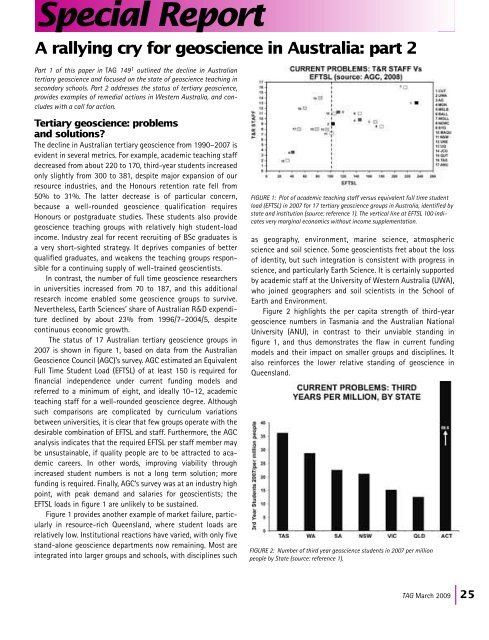The case for a greenfields renaissance Feature - Geological Society ...
The case for a greenfields renaissance Feature - Geological Society ...
The case for a greenfields renaissance Feature - Geological Society ...
Create successful ePaper yourself
Turn your PDF publications into a flip-book with our unique Google optimized e-Paper software.
Special Report<br />
A rallying cry <strong>for</strong> geoscience in Australia: part 2<br />
Part 1 of this paper in TAG 149 1 outlined the decline in Australian<br />
tertiary geoscience and focused on the state of geoscience teaching in<br />
secondary schools. Part 2 addresses the status of tertiary geoscience,<br />
provides examples of remedial actions in Western Australia, and concludes<br />
with a call <strong>for</strong> action.<br />
Tertiary geoscience: problems<br />
and solutions<br />
<strong>The</strong> decline in Australian tertiary geoscience from 1990–2007 is<br />
evident in several metrics. For example, academic teaching staff<br />
decreased from about 220 to 170, third-year students increased<br />
only slightly from 300 to 381, despite major expansion of our<br />
resource industries, and the Honours retention rate fell from<br />
50% to 31%. <strong>The</strong> latter decrease is of particular concern,<br />
because a well-rounded geoscience qualification requires<br />
Honours or postgraduate studies. <strong>The</strong>se students also provide<br />
geoscience teaching groups with relatively high student-load<br />
income. Industry zeal <strong>for</strong> recent recruiting of BSc graduates is<br />
a very short-sighted strategy. It deprives companies of better<br />
qualified graduates, and weakens the teaching groups responsible<br />
<strong>for</strong> a continuing supply of well-trained geoscientists.<br />
In contrast, the number of full time geoscience researchers<br />
in universities increased from 70 to 187, and this additional<br />
research income enabled some geoscience groups to survive.<br />
Nevertheless, Earth Sciences’ share of Australian R&D expenditure<br />
declined by about 23% from 1996/7–2004/5, despite<br />
continuous economic growth.<br />
<strong>The</strong> status of 17 Australian tertiary geoscience groups in<br />
2007 is shown in figure 1, based on data from the Australian<br />
Geoscience Council (AGC)’s survey. AGC estimated an Equivalent<br />
Full Time Student Load (EFTSL) of at least 150 is required <strong>for</strong><br />
financial independence under current funding models and<br />
referred to a minimum of eight, and ideally 10–12, academic<br />
teaching staff <strong>for</strong> a well-rounded geoscience degree. Although<br />
such comparisons are complicated by curriculum variations<br />
between universities, it is clear that few groups operate with the<br />
desirable combination of EFTSL and staff. Furthermore, the AGC<br />
analysis indicates that the required EFTSL per staff member may<br />
be unsustainable, if quality people are to be attracted to academic<br />
careers. In other words, improving viability through<br />
increased student numbers is not a long term solution; more<br />
funding is required. Finally, AGC’s survey was at an industry high<br />
point, with peak demand and salaries <strong>for</strong> geoscientists; the<br />
EFTSL loads in figure 1 are unlikely to be sustained.<br />
Figure 1 provides another example of market failure, particularly<br />
in resource-rich Queensland, where student loads are<br />
relatively low. Institutional reactions have varied, with only five<br />
stand-alone geoscience departments now remaining. Most are<br />
integrated into larger groups and schools, with disciplines such<br />
FIGURE 1: Plot of academic teaching staff versus equivalent full time student<br />
load (EFTSL) in 2007 <strong>for</strong> 17 tertiary geoscience groups in Australia, identified by<br />
state and institution (source: reference 1). <strong>The</strong> vertical line at EFTSL 100 indicates<br />
very marginal economics without income supplementation.<br />
as geography, environment, marine science, atmospheric<br />
science and soil science. Some geoscientists fret about the loss<br />
of identity, but such integration is consistent with progress in<br />
science, and particularly Earth Science. It is certainly supported<br />
by academic staff at the University of Western Australia (UWA),<br />
who joined geographers and soil scientists in the School of<br />
Earth and Environment.<br />
Figure 2 highlights the per capita strength of third-year<br />
geoscience numbers in Tasmania and the Australian National<br />
University (ANU), in contrast to their unviable standing in<br />
figure 1, and thus demonstrates the flaw in current funding<br />
models and their impact on smaller groups and disciplines. It<br />
also rein<strong>for</strong>ces the lower relative standing of geoscience in<br />
Queensland.<br />
FIGURE 2: Number of third year geoscience students in 2007 per million<br />
people by State (source: reference 1).<br />
TAG March 2009 | 25

















